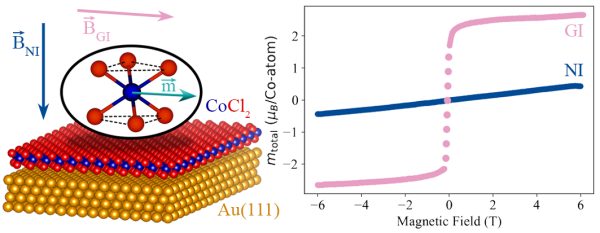Strong In-Plane Magnetism in Semiconducting Monolayer CoCl₂
 Two-dimensional magnets are emerging as key elements for future spin-based electronics, thanks to their layered structure and tunable magnetic properties. Among these, transition metal dihalides (TMDHs) are particularly interesting due to their simple structure and compatibility with nanofabrication techniques. In this work, we demonstrate that epitaxially grown monolayer CoCl₂ on Au(111) is a semiconducting 2D ferromagnet with exceptionally strong in-plane magnetic anisotropy.
Two-dimensional magnets are emerging as key elements for future spin-based electronics, thanks to their layered structure and tunable magnetic properties. Among these, transition metal dihalides (TMDHs) are particularly interesting due to their simple structure and compatibility with nanofabrication techniques. In this work, we demonstrate that epitaxially grown monolayer CoCl₂ on Au(111) is a semiconducting 2D ferromagnet with exceptionally strong in-plane magnetic anisotropy.
Using a combination of surface-sensitive measurement techniques, we characterize the growth, electronic structure, and magnetic response of CoCl₂ down to the atomic scale. Scanning probe microscopy shows that CoCl₂ forms smooth and ordered islands that are isostructural to the bulk phase, with minimal interaction with the underlying Au(111) surface, consistent with the behavior of van der Waals materials. This weak coupling allows the characteristic herringbone reconstruction of the gold substrate to remain intact and enables the CoCl₂ layer to grow continuously across step edges. Although spectroscopic data revealed a large bandgap of approximately 3.9 eV, in-gap states originating from the interface between the CoCl₂ layer and the Au substrate were recorded. These states vary spatially and suggest local electronic modulation due to the lateral mismatch between the bottom Cl layer and Au(111). We also show that the CoCl₂ film modifies the Au(111) surface state by shifting its dispersion to higher energies and simultaneously maintaining a nearly free-electron character, with minimal scattering. Magnetic analysis reveals a Curie temperature of 24 K and a strong in-plane anisotropy, saturating under in-plane magnetic fields below 1 T. In contrast, no saturation is observed for out-of-plane fields up to 6 T. From the two magnetization loops, we calculated an anisotropy field of 31 T, corresponding to an anisotropy energy of 1.6 meV per cobalt atom. This is a surprisingly high value when compared to other 2D magnetic thin-films like CrI₃ or FeCl₂. Importantly, the measured magnetic moment per Co atom is lower than the ideal value predicted by Hund’s rules. This reduction could stem from a combination of crystal field effects, weak orbital overlap with the ligands, and small lattice distortions induced by the substrate. Despite this, the ferromagnetic order remains robust and uniform across different thicknesses.
This study establishes monolayer CoCl₂ as a stable, semiconducting 2D ferromagnet with strong in-plane magnetic anisotropy. Its ability to grow in an orderly fashion via sublimation under mild conditions makes it a promising material for integration into van der Waals heterostructures and nanoscale spintronic technologies.



